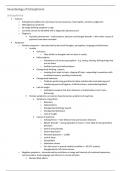Class notes
Molecular Basis of Neuropsychiatric Disorders (ANAT0012) Notes
- Course
- Institution
Explore Molecular Basis of Neuropsychiatric Disorders at UCL. Uncover the intricate facets of schizophrenia, genetics, and the neurobiology of mental diseases. Delve into the realms of drug addiction, depression, severe OCD, learning, memory, anxiety, trauma, dissociation, and the epigenetic dimens...
[Show more]



